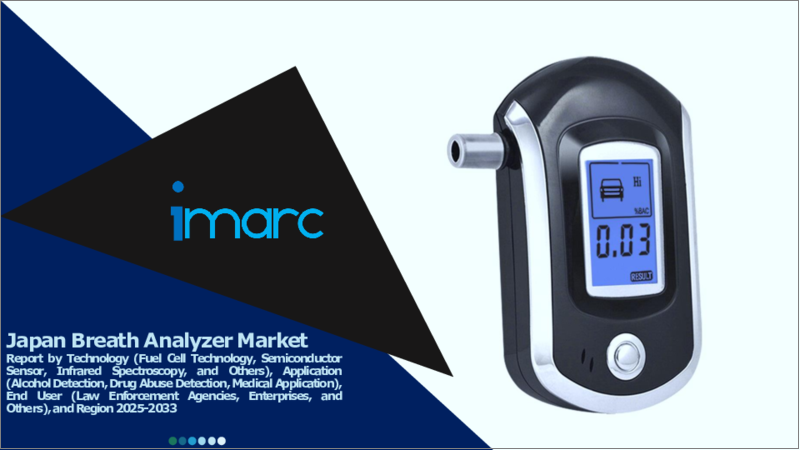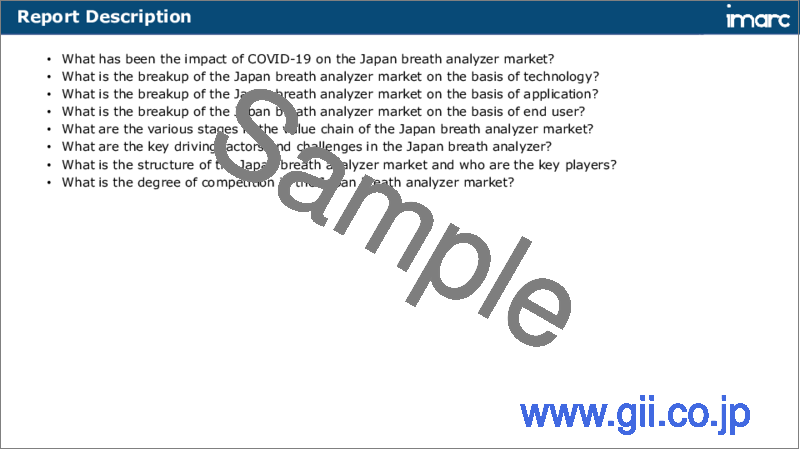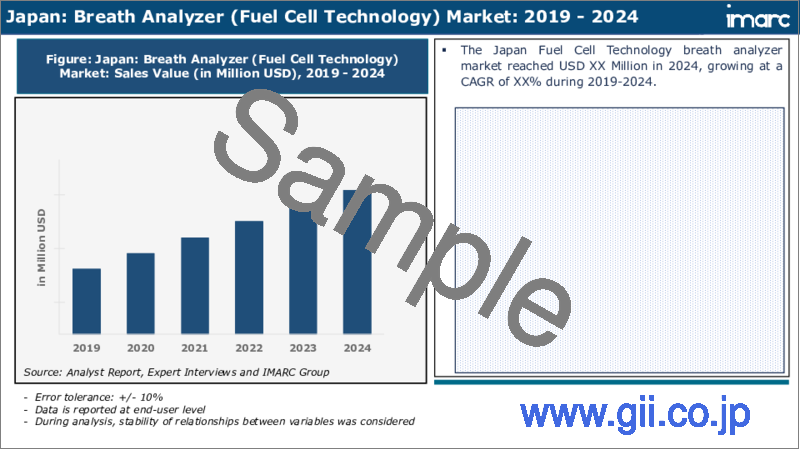|
|
市場調査レポート
商品コード
1746914
呼気分析装置の日本市場:技術別、用途別、エンドユーザー別、地域別、2025年~2033年Japan Breath Analyzer Market Report by Technology, Application, End User, and Region 2025-2033 |
||||||
カスタマイズ可能
|
|||||||
| 呼気分析装置の日本市場:技術別、用途別、エンドユーザー別、地域別、2025年~2033年 |
|
出版日: 2025年06月02日
発行: IMARC
ページ情報: 英文 121 Pages
納期: 5~7営業日
|
全表示
- 概要
- 目次
日本の呼気分析装置市場規模は、2025~2033年の間に13.5%の成長率(CAGR)を示すと予測されます。公共の安全重視の高まりと飲酒運転に伴う危険性についての認識、アルコール・薬物乱用の有病率の上昇、アルコール・薬物検査に関する厳格な法的規制の導入の増加が、市場を牽引する主な要因の一部です。
本レポートで扱う主な質問
- 日本の呼気分析装置市場はこれまでどのように推移し、今後どのように推移するのか?
- COVID-19が日本の呼気分析装置市場に与えた影響は?
- 日本の呼気分析装置市場の技術別区分は?
- 日本の呼気分析装置市場の用途別区分は?
- 日本の呼気分析装置市場のエンドユーザー別区分は?
- 日本の呼気分析装置市場のバリューチェーンにおける様々なステージとは?
- 日本の呼気分析装置の主要な促進要因と課題は何か?
- 日本の呼気分析装置市場の構造と主要プレーヤーは?
- 日本の呼気分析装置市場における競合の程度は?
目次
第1章 序文
第2章 調査範囲と調査手法
- 調査の目的
- ステークホルダー
- データソース
- 市場推定
- 調査手法
第3章 エグゼクティブサマリー
第4章 日本の呼気分析装置市場 - イントロダクション
- 概要
- 市場力学
- 業界動向
- 競合情報
第5章 日本の呼気分析装置市場情勢
- 過去および現在の市場動向(2019~2024年)
- 市場予測(2025~2033年)
第6章 日本の呼気分析装置市場 - 技術別内訳
- 燃料電池技術
- 半導体センサー
- 赤外分光法
- その他
第7章 日本の呼気分析装置市場 - 用途別内訳
- アルコール検知
- 薬物乱用検出
- 医療用途
第8章 日本の呼気分析装置市場 - エンドユーザー別内訳
- 法執行機関
- 企業
- その他
第9章 日本の呼気分析装置市場 - 競合情勢
- 概要
- 市場構造
- 市場企業のポジショニング
- 主要成功戦略
- 競合ダッシュボード
- 企業評価象限
第10章 主要企業のプロファイル
第11章 日本の呼気分析装置市場 - 業界分析
- 促進要因・抑制要因・機会
- ポーターのファイブフォース分析
- バリューチェーン分析
第12章 付録
Japan breath analyzer market size is projected to exhibit a growth rate (CAGR) of 13.5% during 2025-2033. The growing emphasis on public safety and awareness about the dangers associated with impaired driving, rising prevalence of alcohol and drug abuse, and increasing implementation of stringent legal regulations pertaining to alcohol and drug testing represent some of the key factors driving the market.
A breath analyzer is a device designed to measure the alcohol content in the breath of an individual. It comprises evidential breath testers (EBTs), which are used by law enforcement and designed to meet strict legal standards for accuracy and reliability. It also includes preliminary breath testers (PBTs), which are handheld devices commonly used by law enforcement officers during traffic stops to provide a quick indication of impairment. It provides an objective and non-invasive method for determining impairment, reducing the subjectivity associated with field sobriety tests. It is quick and efficient, allowing law enforcement to screen many individuals during routine traffic stops. It operates on the principle of infrared spectroscopy, electrochemical fuel cells, or semiconductor sensors to detect and quantify the alcohol concentration in the breath of individuals. It helps prevent accidents and fatalities by identifying individuals who are driving under the influence of alcohol. It helps to protect both employees and the public from the risks associated with impaired workers in various safety-sensitive industries. It also assists in monitoring and supporting individuals in their recovery from alcohol addiction.
Japan Breath Analyzer Market Trends:
At present, the increasing emphasis on public safety and the awareness about the dangers associated with impaired driving represents one of the crucial factors impelling the growth of the market in Japan. Besides this, the rising prevalence of alcohol and drug abuse among the masses to cope with work stress and depression is contributing to the market growth in the country. In addition, the growing technological advancements and the integration of features, such as real-time monitoring, wireless connectivity, and smartphone compatibility of breath analyzers, are making them more user-friendly and effective. Apart from this, stringent legal regulations pertaining to alcohol and drug testing, and the rising number of road accidents and fatalities attributed to impaired driving, are compelling law enforcement agencies to adopt breath analyzers as a vital tool for ensuring road safety. Additionally, rising concerns about workplace safety and the need to maintain a drug-free working environment are driving the adoption of breath analyzers among employers, especially in industries wherein safety is of paramount importance. Moreover, advancements in sensor technology, including fuel cell-based and infrared sensors, are improving the accuracy and reliability of breath analyzers. This is also increasing the adoption of breath analyzers for clinical applications, such as monitoring alcohol levels in patients with alcohol use disorders and monitoring ketone levels in individuals on low-carb diets.
Japan Breath Analyzer Market Segmentation:
Technology Insights:
- Fuel Cell Technology
- Semiconductor Sensor
- Infrared Spectroscopy
- Others
Application Insights:
- Alcohol Detection
- Drug Abuse Detection
- Medical Application
End User Insights:
- Law Enforcement Agencies
- Enterprises
- Others
Competitive Landscape:
The market research report has also provided a comprehensive analysis of the competitive landscape. Competitive analysis such as market structure, key player positioning, top winning strategies, competitive dashboard, and company evaluation quadrant has been covered in the report. Also, detailed profiles of all major companies have been provided.
Key Questions Answered in This Report:
- How has the Japan breath analyzer market performed so far and how will it perform in the coming years?
- What has been the impact of COVID-19 on the Japan breath analyzer market?
- What is the breakup of the Japan breath analyzer market on the basis of technology?
- What is the breakup of the Japan breath analyzer market on the basis of application?
- What is the breakup of the Japan breath analyzer market on the basis of end user?
- What are the various stages in the value chain of the Japan breath analyzer market?
- What are the key driving factors and challenges in the Japan breath analyzer?
- What is the structure of the Japan breath analyzer market and who are the key players?
- What is the degree of competition in the Japan breath analyzer market?
Table of Contents
1 Preface
2 Scope and Methodology
- 2.1 Objectives of the Study
- 2.2 Stakeholders
- 2.3 Data Sources
- 2.3.1 Primary Sources
- 2.3.2 Secondary Sources
- 2.4 Market Estimation
- 2.4.1 Bottom-Up Approach
- 2.4.2 Top-Down Approach
- 2.5 Forecasting Methodology
3 Executive Summary
4 Japan Breath Analyzer Market - Introduction
- 4.1 Overview
- 4.2 Market Dynamics
- 4.3 Industry Trends
- 4.4 Competitive Intelligence
5 Japan Breath Analyzer Market Landscape
- 5.1 Historical and Current Market Trends (2019-2024)
- 5.2 Market Forecast (2025-2033)
6 Japan Breath Analyzer Market - Breakup by Technology
- 6.1 Fuel Cell Technology
- 6.1.1 Overview
- 6.1.2 Historical and Current Market Trends (2019-2024)
- 6.1.3 Market Forecast (2025-2033)
- 6.2 Semiconductor Sensor
- 6.2.1 Overview
- 6.2.2 Historical and Current Market Trends (2019-2024)
- 6.2.3 Market Forecast (2025-2033)
- 6.3 Infrared Spectroscopy
- 6.3.1 Overview
- 6.3.2 Historical and Current Market Trends (2019-2024)
- 6.3.3 Market Forecast (2025-2033)
- 6.4 Others
- 6.4.1 Historical and Current Market Trends (2019-2024)
- 6.4.2 Market Forecast (2025-2033)
7 Japan Breath Analyzer Market - Breakup by Application
- 7.1 Alcohol Detection
- 7.1.1 Overview
- 7.1.2 Historical and Current Market Trends (2019-2024)
- 7.1.3 Market Forecast (2025-2033)
- 7.2 Drug Abuse Detection
- 7.2.1 Overview
- 7.2.2 Historical and Current Market Trends (2019-2024)
- 7.2.3 Market Forecast (2025-2033)
- 7.3 Medical Application
- 7.3.1 Overview
- 7.3.2 Historical and Current Market Trends (2019-2024)
- 7.3.3 Market Forecast (2025-2033)
8 Japan Breath Analyzer Market - Breakup by End User
- 8.1 Law Enforcement Agencies
- 8.1.1 Overview
- 8.1.2 Historical and Current Market Trends (2019-2024)
- 8.1.3 Market Forecast (2025-2033)
- 8.2 Enterprises
- 8.2.1 Overview
- 8.2.2 Historical and Current Market Trends (2019-2024)
- 8.2.3 Market Forecast (2025-2033)
- 8.3 Others
- 8.3.1 Historical and Current Market Trends (2019-2024)
- 8.3.2 Market Forecast (2025-2033)
9 Japan Breath Analyzer Market - Competitive Landscape
- 9.1 Overview
- 9.2 Market Structure
- 9.3 Market Player Positioning
- 9.4 Top Winning Strategies
- 9.5 Competitive Dashboard
- 9.6 Company Evaluation Quadrant
10 Profiles of Key Players
- 10.1 Company A
- 10.1.1 Business Overview
- 10.1.2 Product Portfolio
- 10.1.3 Business Strategies
- 10.1.4 SWOT Analysis
- 10.1.5 Major News and Events
- 10.2 Company B
- 10.2.1 Business Overview
- 10.2.2 Product Portfolio
- 10.2.3 Business Strategies
- 10.2.4 SWOT Analysis
- 10.2.5 Major News and Events
- 10.3 Company C
- 10.3.1 Business Overview
- 10.3.2 Product Portfolio
- 10.3.3 Business Strategies
- 10.3.4 SWOT Analysis
- 10.3.5 Major News and Events
- 10.4 Company D
- 10.4.1 Business Overview
- 10.4.2 Product Portfolio
- 10.4.3 Business Strategies
- 10.4.4 SWOT Analysis
- 10.4.5 Major News and Events
- 10.5 Company E
- 10.5.1 Business Overview
- 10.5.2 Product Portfolio
- 10.5.3 Business Strategies
- 10.5.4 SWOT Analysis
- 10.5.5 Major News and Events
11 Japan Breath Analyzer Market - Industry Analysis
- 11.1 Drivers, Restraints, and Opportunities
- 11.1.1 Overview
- 11.1.2 Drivers
- 11.1.3 Restraints
- 11.1.4 Opportunities
- 11.2 Porters Five Forces Analysis
- 11.2.1 Overview
- 11.2.2 Bargaining Power of Buyers
- 11.2.3 Bargaining Power of Suppliers
- 11.2.4 Degree of Competition
- 11.2.5 Threat of New Entrants
- 11.2.6 Threat of Substitutes
- 11.3 Value Chain Analysis





